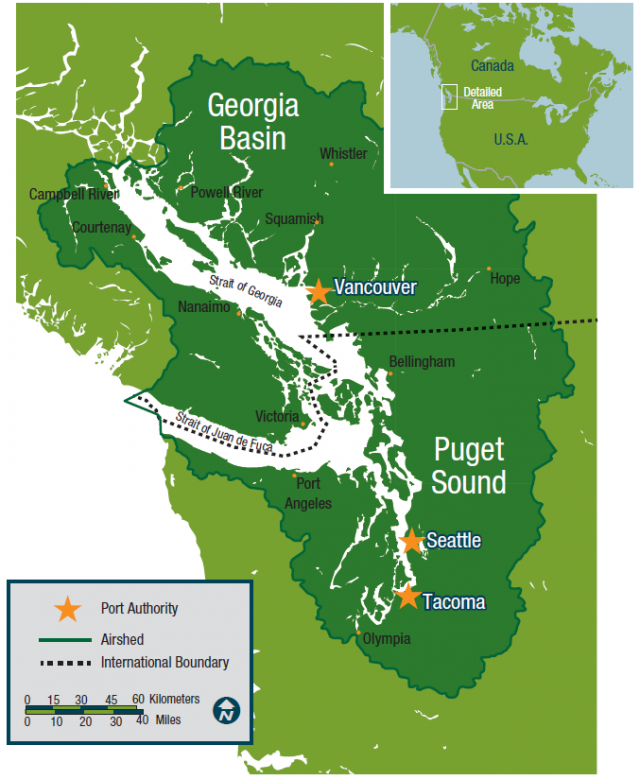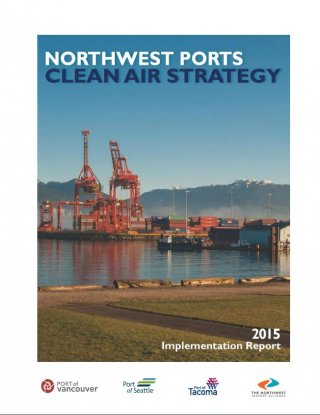Northwest Ports Achievements in Reducing Emissions and Improving Performance
- Overview
- Goals and objectives
- Tracking progress through Implementation Reports
- Programs implemented to achieve goals and targets
Overview
The Port of Seattle, Port of Tacoma, and Port Metro Vancouver (Vancouver Fraser Port Authority), Canada have been reducing emissions and meeting performance targets to improve air quality. They are achieving these improvements through the Northwest Ports Clean Air Strategy (the Strategy).
- The Puget Sound Clean Air Agency;
- The U.S. EPA;
- Environment Canada;
- Washington State Department of Ecology; and
- Industry and community stakeholders.
- In 2007, maritime emission inventories were utilized to develop the initial Strategy.
- In 2013, the Strategy was modified to incorporate recent adopted measures as well as results from the 2011 maritime emissions inventory.
- Efforts are underway for development of a 2016 emissions inventory.
- Northwest Ports Clean Air Strategy
- Northwest Ports Clean Air Strategy 2020 (pdf) (2.0 MB)
- 2016 Implementation Report (pdf) (5.8 MB, November 2017)
Goals and Objectives
Objectives

- Reduce maritime and port-related air quality impacts from diesel particulate matter on human health, the environment, and economy.
- Reduce greenhouse gas emissions and associated environmental, health and economic impacts.
- Help the Georgia Basin - Puget Sound airshed continue to meet air quality standards and objectives.
The key goals of the joint strategy are to stay within attainment of ambient air quality standards and objectives and to continue to improve emissions and performance.
Emission Goals
The Strategy sets emission percentage reduction goals in two key areas as noted below.
- Reduce diesel particulate matter (DPM) emissions per ton of cargo by 75 percent of 2005 levels by 2015 and 80 percent by 2020.
- Reduce greenhouse gas emissions (GHGs) per ton of cargo by 10 percent from 2005 levels by 2015 and 15 percent by 2020.
Performance Targets
Tracking Progress through Implementation Reports

Annual implementation reports have been tracking progress on meeting objectives, emission goals and performance targets of the Strategy since 2008. Strategy actions and efforts are driven by the Ports’ unique and collaborative relationships with industry, agencies and other stakeholders to achieve early reductions in advance of, and complementary to, applicable regulations. The most recent assessment of progress is the
Northwest Ports Clean Air Strategy 2016 Implementation Report (pdf). (6 MB, November 2017)
Emission Outcomes
- Diesel particulate matter per metric ton of cargo reduced 22 percent between 2005 and 2011.
- Greenhouse gas emissions per metric ton of cargo reduced 9 percent between 2005 and 2011
The 2016 maritime emissions inventory is under development with a planned release in later 2017 or early 2018. Emission reduction outcomes will be updated once the 2016 emissions inventory is completed.
Report on Performance Targets
The following performance targets for 2020 have been met.
- Fifty-three percent of vessel calls participate in port-designed or third-party certification programs for ocean going vessels , compared to a performance target of 40 percent.
- Partners are conducting outreach with regard to harbor vessels.
- Ports have fuel efficiency plans for cargo handling equipment.
- All ports have reduced the size of fleets.
- Ports report use of cleaner vehicles and equipment and other relevant information.
- Ports have adopted clean construction practices for port-led construction projects.
- Each port has conducted at least 3 energy studies.
- Ports participate in third-party certification programs (3 ports participating)
- Ninety percent of harbor vessel companies report best practices and engine upgrades (30 percent reported, and 25 percent of companies performed engine upgrades and best practices)
- Eighty percent of cargo handling equipment meets Tier 4 interim emissions standards or equivalent (39 percent have met this standard)
- One hundred percent of terminals have fuel-efficiency plans for cargo handling equipment (24 percent have met this)
- One hundred percent of trucks meet or surpass EPA emission standards for model year 2007 by 2017 (45 percent have achieved this)
- Ports have fuel-efficiency plans for trucks (no ports have completed this)
- Fifty percent of truck companies have fuel-efficiency plans (25 percent of truck companies participated in SmartWay at one port)
- One hundred percent of switcher locomotives owners/operators achieve performance measure of chosen fuel-efficiency program (5 percent complete, but data is incomplete)
- Twenty percent of unregulated switcher locomotive engines are upgraded or replaced to Tier 2 or better (seven percent are upgraded or replaced, but data is incomplete)
For more detail on progress toward meeting performance targets, go to 2016 Implementation Report - Table E-1 (pdf) (5.8 MB, November 2017)
Programs Implemented to Achieve Goals and Targets
Various programs have been implemented to help the ports reach their emission goals and performance targets.
Clean Truck Program
Under the Clean Truck Program, trucks entering container terminals must have a model-year 1994 or newer engine and must meet other requirements to reduce emissions. Additionally, beginning January 1, 2018, drayage trucks will be required to have model-year 2007 or newer engines.
Seaport Truck Scrappage and Replacements for Air in Puget Sound (ScRAPS 2)
To help truck owners reach the standards of the Clean Truck Program, the ports, along with the Puget Sound Clean Air Agency, have created Seaport Truck Scrappage and Replacements for Air in Puget Sound (ScRAPS 2), a program funded by state and federal grants that partially funds the replacement of eligible trucks. So far, nearly 350 trucks have been scrapped and replaced under ScRAPS 2.
